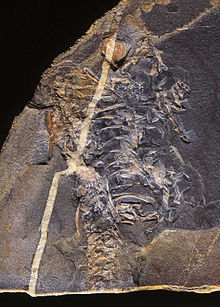| Casineria Temporal range: Early Carboniferous,
| |
|---|---|

| |
| The counterslab of the holotype fossil | |
| Scientific classification | |
| Domain: | Eukaryota |
| Kingdom: | Animalia |
| Phylum: | Chordata |
| Clade: | Sarcopterygii |
| Clade: | Tetrapodomorpha |
| Clade: | Eotetrapodiformes |
| Clade: | Elpistostegalia |
| Clade: | Stegocephali |
| Genus: | †Casineria Paton, Smithson & Clack, 1999 |
| Type species | |
| †Casineria kiddi Paton, Smithson & Clack, 1999
| |
Casineria is an extinct genus of tetrapodomorph which lived about 340–334 million years ago in the Mississippian epoch of the Carboniferous period. Its generic name, Casineria, is a latinization of Cheese Bay, the site near Edinburgh, Scotland, where the holotype fossil was found.[1] When originally described in 1999, it was identified as a transitional fossil noted for its mix of basal (amphibian-like) and advanced (reptile-like) characteristics, putting it at or very near the origin of the amniotes, the group containing all mammals, birds, modern reptiles, and other descendants of their reptile-like common ancestor. However, the sole known fossil is lacking key elements such as a skull, making exact analysis difficult.[2] As a result, the classification of Casineria has been more controversial in analyses conducted since 1999. Other proposed affinities include a placement among the lepospondyls,[3] seymouriamorphs,[4] "gephyrostegids",[5] or as a synonym of Caerorhachis, another controversial tetrapod which may have been an early temnospondyl.[6]
- ^ Paton, R. L.; Smithson, T. R.; Clack, J. A. (8 April 1999). "An amniote-like skeleton from the Early Carboniferous of Scotland". Nature. 398 (6727): 508–513. Bibcode:1999Natur.398..508P. doi:10.1038/19071. ISSN 0028-0836. S2CID 204992355.
- ^ Monastersky, R. (1999): Out of the Swamps, How early vertebrates established a foothold—with all 10 toes—on land, Science News vol. 155, No. 21, p. 328
- ^ Clack, Jennifer A.; Witzmann, Florian; Müller, Johannes; Snyder, Daniel (2012-10-18). "A Colosteid-Like Early Tetrapod from the St. Louis Limestone (Early Carboniferous, Meramecian), St. Louis, Missouri, USA". Fieldiana Life and Earth Sciences. 5: 17–39. doi:10.3158/2158-5520-5.1.17. ISSN 2158-5520. S2CID 129964161.
- ^ Clack, Jennifer A.; Bennett, Carys E.; Carpenter, David K.; Davies, Sarah J.; Fraser, Nicholas C.; Kearsey, Timothy I.; Marshall, John E. A.; Millward, David; Otoo, Benjamin K. A. (2016-12-05). "Phylogenetic and environmental context of a Tournaisian tetrapod fauna". Nature Ecology & Evolution. 1 (1): 0002. doi:10.1038/s41559-016-0002. hdl:2381/40933. ISSN 2397-334X. PMID 28812555. S2CID 22421017.
- ^ Marjanović, David; Laurin, Michel (2019-01-04). "Phylogeny of Paleozoic limbed vertebrates reassessed through revision and expansion of the largest published relevant data matrix". PeerJ. 6: e5565. doi:10.7717/peerj.5565. ISSN 2167-8359. PMC 6322490. PMID 30631641.
- ^ Cite error: The named reference
:1was invoked but never defined (see the help page).